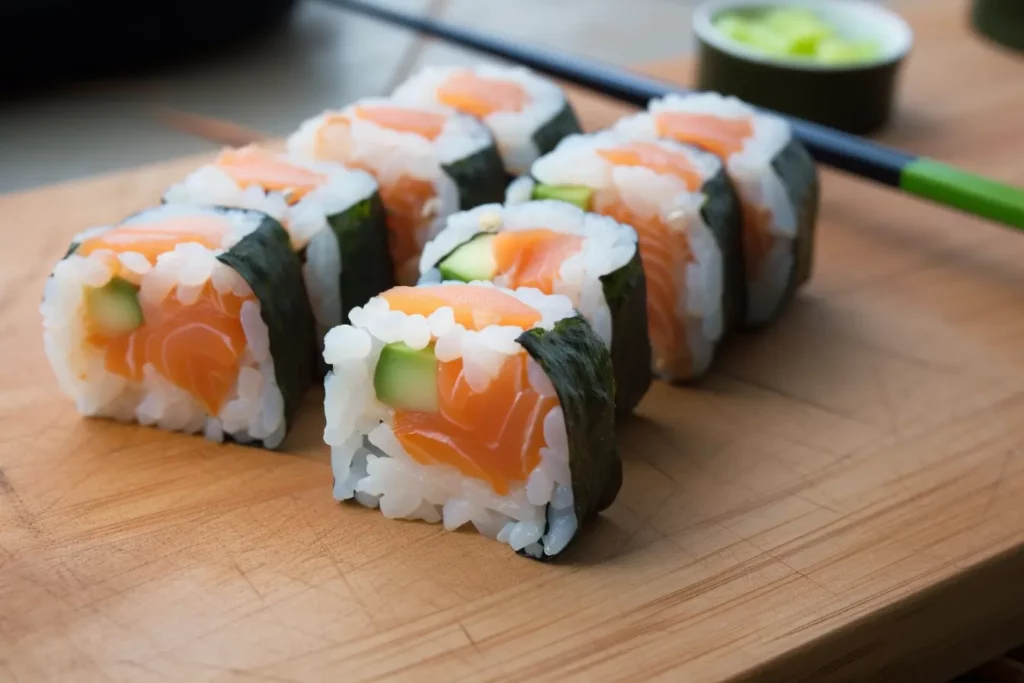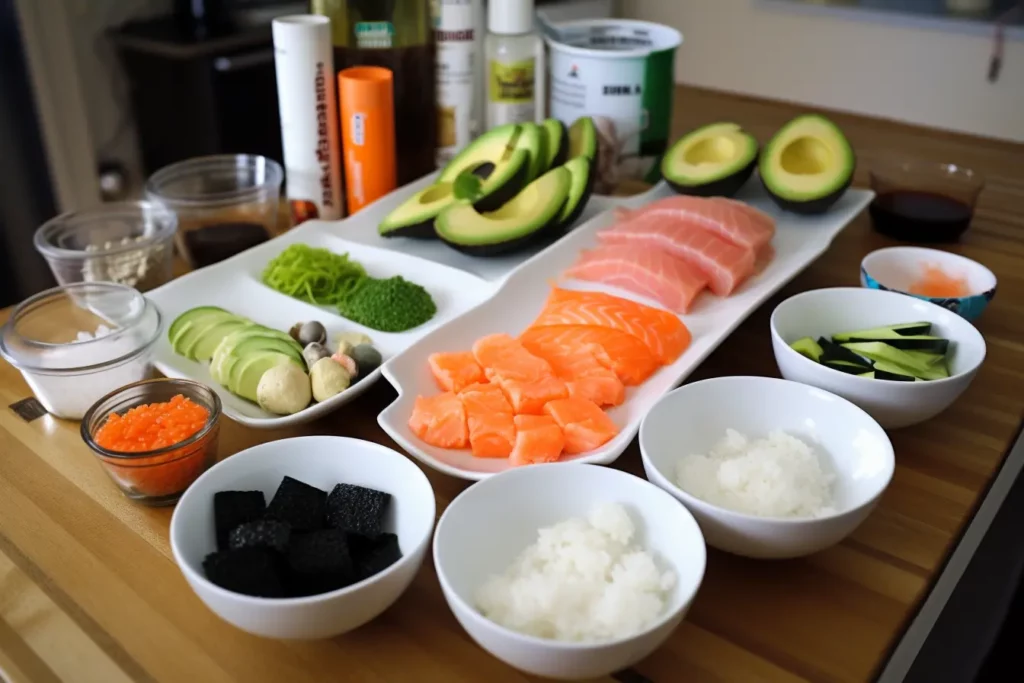The art of sushi, a culinary practice that goes far beyond simply putting ingredients together, is deeply rooted in the careful application of ancient methods. The process of fermentation, an integral part of this culinary delight, is at the heart of the transformation of simple raw materials into flavorful delicacies. This essay explores the fundamental phenomenon of fermentation – an alchemical journey in which natural microorganisms shape the taste, texture and cultural value of sushi. From the depths of its historical origins to the health benefits and refined techniques of fermentation, we will explore the scientific and aesthetic intricacies of this ancient craft and understand how it has evolved into a globally appreciated palate experience.
Basics of fermentation
Fermentation and sushi – a stylish duo of culinary excellence
When it comes to the art of sushi, it’s not just a visual masterpiece on the plates, it’s also a matter of subtle flavors developed through the sophisticated technique of fermentation. This process, deeply rooted in centuries-old Japanese tradition, is the well-kept secret behind the exquisite taste sensations that transform sushi into a piece of edible haute couture.
Fermentation is a type of food preservation based on the natural conversion of sugars into alcohol or organic acids by microorganisms. In the case of sushi, it is not only a preservative, but also a crucial flavor enhancer. One of the key components of sushi is the Shari – the spiced sushi rice. The rice is enriched with a mixture of rice vinegar, sugar and salt, which first ferments so that the aromas can penetrate deep into the grain and give it a subtle but distinctive taste.
Even more important, however, is the fermentation of the fish. Historically, this tradition has its origins in the need to preserve fish without a refrigerator. Today, it is used to unleash the full potential of the fishy flavor. Narezushi, the grandfather of modern sushi, is the oldest form in which whole fish were fermented with rice and then stored for months until they reached this unique, rich seasoning.
Modern methods, such as the shorter maturation time of sashimi, also use a wide variety of fermentation approaches. The fish can be inoculated with koji mold – a type of fungal culture that is also used to make soy sauce and miso – to achieve gentle ripening and bringing out umami-rich flavor components. This helps sushi retain its light and delicate texture while offering deeper and more complex flavors.
The aesthetics that we are so enraptured by are therefore completed not only by meticulous craftsmanship and presentation, but also by the refined nuances of taste created by fermentation. These date back to the beginnings of sushi culture and are now celebrated in modern cuisine with a touch of trend awareness and design understanding.
To enjoy this culinary work of art, it is essential to take your time and take in the different tastes and textures. Because sushi and its refined ability to create a symphony of flavors through fermentation is more than a trend – it’s a lifestyle, a devotion to beauty and flavor that culminates in the mouth.

Historical development of sushi
Fermentation and sushi: a symbiosis of tradition and taste
In the world of sushi, patience is not just a virtue, but a component that defines the pithy taste and impeccable presentation. Today’s sushi culture combines tradition with modern technologies and innovations, with fermentation continuing to play an essential role.
Sushi connoisseurs are well aware that the skillful application of fermentation techniques elevates the entire dining experience to a level of luxury. For example, top sushi masters perfect the use of fermented vinegar to give the Shari, the sushi rice, its characteristic shiny glow. This process emphasizes the natural sweetness of the rice and forms the ultimate foundation for the delicacies draped on it.
Not forgetting the fermented sauces that envelop the fresh fish, giving it a deep umami note. These are often cherished and cared for for years, so their complex depth of flavour and glossy texture transform every bite of sushi into a feast for the senses.
The transition from Narezushi to today’s forms of sushi is a testament to how culture and gastronomy evolve together. While fermentation was originally necessary to preserve the fish over a long period of time, today the focus is on refining its taste. The types of fish used for modern sushi creations often go through a shortened fermentation process that aims to intensify the flavors without preserving the fish for too long.
In addition, the former necessity of preservation through fermentation has now found a new meaning – it is a statement of luxurious slowness in a fast-paced world. Waiting for the fermented product to be perfected is a symbol of appreciation for craftsmanship and quality.
The creation of aesthetically pleasing sushi is a holistic process that combines visual appearance with exceptional taste. The use of fermented components is more than just a preparation method; it is a feature that adds depth and authenticity to the art of sushi. Thus, every sushi presentation becomes a tribute to the centuries-old traditions that illustrate the living connection between past and present.
After all, every stage of sushi making reflects the dedication to creating a unique flavor composition through fermentation – a tribute to the unceasing beauty of this timeless art form.

Health Aspects of Sushi Fermentation
Beyond the Sushi Plate: Health and Vitality Through Fermentation
Fermentation is not only considered a historical heritage in traditional cuisine, but also a key to a healthy lifestyle. The magic of fermented foods extends far beyond mere taste.
Try kombucha, this refreshing, bubbly drink that is experiencing a real turnaround as an energy booster and immune system supporter. The beneficial bacteria found in kombucha are masters at supporting the balance of gut flora – a flora that is increasingly turning out to be our second brain. That’s right, these tiny microorganisms are partly responsible for our moods and general well-being.
A look at the fermented vegetables, such as sauerkraut or kimchi, reveals an abundance of probiotics that promote our digestion. They help to break down food better and thus absorb nutrients more efficiently. In addition, fermentation is particularly appreciated for those who fight lactose intolerance – for example, by consuming fermented yogurt, which is easier to digest.
Let’s look at lactic acid, which is produced during fermentation and acts as a natural preservative by repelling pathogenic germs. Through this cell-protecting process, fewer toxins enter our body and our immune system can breathe a sigh of relief.
Another plus: fermentation creates additional nutrients such as vitamin B12 and K2, essential especially for those who follow a plant-based diet. And while we enjoy this health added value, our ecological awareness is rewarded by sustainable consumption – because fermented foods reduce the need for energy and chemical consumption for preservation.
And finally, as guardians of good taste, we must not forget how fermentation releases enzymes that create complex flavor profiles in the first place. These culinary sensations, which will send every ambitious gourmand into ecstasy, touch the soul and refine the palate.
With a deeper understanding of this ancient technique, fermentation becomes not only an enrichment on the plate, but a synonym for a vital, healthy and conscious life. The constant rediscovery and innovation in the field of fermentation is a clear sign that this ancestral wisdom is celebrating a contemporary revival – and it’s a matter of style to join in. Because when it comes to well-being, fermentation is definitely more than just a fleeting trend – it’s a way of life.
So, the next time you’re enjoying a piece of kimchi-accentuated saffron risotto or toasting life with a cool kombucha, remember the profound benefits these ancient methods bring to our modern world. Enjoy each ferment with the knowledge that you are doing a true favor not only for your tongue, but also for your health. Cheers to fermentation – the stylish alchemy of life!

Fermentation Techniques and Practice
Fermentation Techniques in Sushi Cooking: More Than Just Taste
When we immerse ourselves in the fascinating world of sushi, we witness an elegant dance between tradition and innovation. Fermentation, in particular, is an essential element that goes far beyond mere taste enhancement. Sushi chefs have mastered a range of techniques that are as versatile as they are sophisticated.
One of the central processes is the production of fermented sushi rice vinegar. It is not only the selection of the best rice varieties that plays a role, but also the refined interplay of rice vinegar, sugar and salt. This trio is crucial to the Shari, the heart of sushi, and gives it its typical delicate acidity.
The sought-after umami, known as the fifth taste, is achieved with the addition of fermented sauces such as soy sauce and miso. It is through these condiments, which acquire a flavor intensity through long fermentation cycles, that sushi gains its depth and complexity.
Handling raw fish also requires mastery of various fermentation techniques. Careful fermentation at a controlled temperature not only breaks down pathogenic microorganisms, but also ensures a fine texture and tasty aroma.
The symbiosis between fish and rice in nigiri sushi is a prime example of how a culinary masterpiece is created thanks to centuries-old fermentation techniques. Here, just a few hours of maturation are enough to make the fish more tender and harmoniously marry the aromas.
Modern sushi cuisine also benefits from classic fermentation. In the age of fast-paced life and mass production, sushi chefs consciously celebrate the value of patient manual work. The addition of shiso leaves or umeboshi, fermented Japanese plums, emphasizes the commitment to authenticity.
Another essential technique is marinating fish in acid, typically vinegar or citrus, which is called rapid fermentation. This process, which is popular with dishes such as ceviche, changes the texture and flavor of the fish almost instantly, creating a refreshing taste experience.
In an effort to promote sustainability and a conscious diet, fermented products are given pride of place in the sushi craft. Not only are they considered rich in probiotic cultures, but they also play a central role in the quest for a more environmentally friendly and healthy lifestyle.
Finally, we shed light on the aesthetics of sushi, where fermentation should not be underestimated. Through the use of this ancient technique, unique nuances in both color and texture find their way into the sushi presentation, turning each creation into a small work of art. The combination of sensual sensations and health-promoting properties reflects the true essence of a thoughtful and at the same time aesthetic lifestyle.

Aesthetics and presentation of fermented sushi
If you look at modern sushi culture, the art of fermentation is an indispensable part of the cuisine that aims at style, health and conscious consumption. The fine handling of fermented sushi rice vinegar does more than just balance flavors; it expands the sensory profile of this illustrious dish. The selection and dosage of this vinegar is a science in itself and adds to the visual appeal of each piece of sushi – it’s about more than just food culture, it’s a true design philosophy.
When talking about the importance and influence of fermentation on the representation of sushi, it’s not just about the depth of taste. Modern sushi masters use classic fermentation techniques to connect with traditional cuisine and refine their creations. The sophistication with which fermented sauces such as soy sauce and miso are integrated into the creations shapes the taste experience as much as the visual appearance.
But beyond the plate, the fermentation of raw fish in sushi preparation has gained enormous importance for sustainability and the promotion of conscious nutrition. We work with the resources of nature, not against it. This symbiosis of naturalness and culinary skill radiates from the impeccably arranged sushi platters and inspires aesthetes and health-conscious alike alike.
Furthermore, the use of acid to marinate fish for a short period of time is a form of rapid fermentation that helps improve the texture and presentation of nigiri sushi. Sushi lovers rave about the velvety consistency and harmonious taste symbiosis achieved by this process. The look of the finished product – often a kaleidoscope of colours and shapes – is not only a delight for the palate, but also a feast for the eyes.

The delicate interplay of taste, health and artistry that is revealed in the world of fermented sushi is a testament to human creativity and tradition. The respectful use of time and the mastery of procedures that steer natural processes to culinary heights reflects the high school of sushi masters. Fermentation not only unfolds a palette of aromas, but also an aesthetic that challenges and delights our senses. This clearly shows that the science and practice behind fermented sushi is much more than just the preparation of food – it is a form of poetry that carries with every bite what centuries of culture have to give us.


